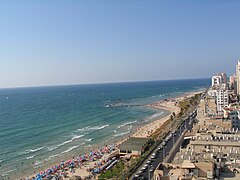Bat Yam


Bat Yam (Hebrew: בת ים) is a city in Israel, on the central coastal strip, just south of Tel Aviv, and part of the Gush Dan metropolitan area, in the Tel Aviv District.
The key feature of Bat Yam is its beautiful beach on the Mediterranean Sea, attracting tourists every summer.
History
Bat Yam was established in 1926 as Bayit VaGan (Hebrew: בית וגן, House and Garden), and was geared toward Orthodox Jews. During the 1929 Palestine riots, Bayit VaGan came under attacks by Arab gangs from neighbouring Jaffa and was evacuated by British Authorities, then was reestablished in 1930. In 1936 it was given the status of local council.
Bayit VaGan's name was changed in 1938 to Bat Yam. The 1948 Arab-Israeli War reached its borders, and Bat Yam was under heavy fire from Jaffa, until Jaffa surrendered on May 13, 1948.
In the first decades of Israel's independence Bat Yam grew due to mass immigration, becoming a local council in 1949 and a city in 1958. It experienced a rapid growth again in early 1990s, as many immigrants from former Soviet Union chose Bat Yam as their new residence because of its proximity to industrial centres of the country, combined with relatively low real estate prices. According to Israeli Central Bureau of Statistics, the city population as of June 2005 is some 130,000 people.
Present-day Bat Yam suffers from several stigmas as a result of a problematic socio-economic structure of its population. Because of relatively low real estate prices and a massive and crowded building boom during the 1970s and 1980s, Bat Yam saw a large influx of new inhabitants from lower socio-economic strata, mainly second- and third generation descendants from lower-class immigrants from Arab countires, and lower-class immigrants from the foremer Soviet Union. Concurrently, middle-class inhabitants of Bat Yam started to move out, primarily to the newer suburbs of Rishon LeZion, a boomtown south of Bat Yam.
The socio-economic decline of the town, and the finacial scandals resulting from the steadily declining local leadership, brought Bat Yam to the brink of bankrupcy in the eartly 2000s. During that period, the name Bat Yam was commonly associated with urban decay, streets filled with heaps of household and building refuse which was only rarely collected if at all, by the city's sanitation department.
Since the mid-2000s, the new leadership headed by mayor Shlomo Lahiani is trying to revert this trend, with mixed success. Some areas of Bat Yam have undergone - and are undergoing - a veritable transformation. On the other hand, many areas of the city continue to suffer from utter neglect, manifesting itself in tons of urban household waste strewn across vast areas of the city, parts of which are cleaned by municipality personnel only occasionally, and then very superficially.
Leaders
| Type | Name | Years |
|---|---|---|
| Head of council | Mintz Ben Zion | 1936-1937 |
| Head of council | Israel Ben Zion | 1937-1939 |
| Head of council | Israel Rabinovich-Teomim | 1939-1943 |
| Head of council | Eliav Levai | 1943-1950 |
| Head of council | David Ben Ari | 1950-1958 |
| Mayor | David Ben Ari | 1958-1963 |
| Mayor | Menahem Rothschild | 1963-1973 |
| Mayor | Yitzhak Walker | 1973-1977 |
| Mayor | David Mesika | 1977-1978 |
| Mayor | Menahem Rothschild | 1978-1983 |
| Mayor | Ehud Kanmon | 1983-1993 |
| Mayor | Yehoshua Sagi | 1993-2003 |
| Mayor | Shlomo Lahiani | 2003-date |
Twin cities
-
The municipality building.
-
The beach, south.
-
Kikar ha-Meginim (The Defenders Square).
-
Bat Yam from the Azrieli Towers in Tel Aviv.





